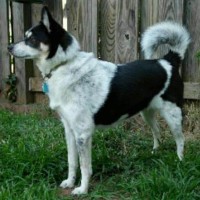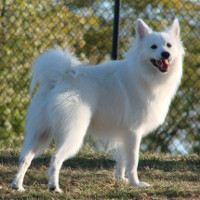Appearance of the American Eagle Dog
|
| Depending on whether your American Eagle Dog is male or female, weight will vary between 9 and 22.5 kilos, making this hybrid a small to medium-sized dog breed. The coat is generally thick, dense and straight, requiring constant brushing, and can vary in color, including cream, white with cream, black and white with brown. There may be a mane-like appearance around the neck, although this distinct characteristic is most often seen in males of the breed. The ears are often floppy, and the eyelids, nose and pads are most often black. |
Temperament of the American Eagle Dog
|
| This specific crossbreed or hybrid dog is highly intelligent, affectionate and loving, making the breed an excellent family dog or companion. They are extroverts who can be trained easily if they have a firm but not harsh leader, and like consistency in all things. The American Eagle Dog is energetic and playful, and loves to take part in family games. They like to be with their family and don't like to be left alone for long periods. If left alone in a small yard, the dog can be quite destructive and has nothing to do but fall into mischief. The American Eagle Dog combines the best characteristics of its parent breeds, the Beagle and the American Eskimo Dog. The Beagle was bred for hunting and likes to follow its nose, while the American Eskimo Dog was often used as a circus performer performing tricks. Both breeds are attractive and intelligent. By forming a hybrid breed from the two, a dog was produced that was sociable, easy to train and excellent with children. However, they are known to chew and dig unless they are busy and trained to behave. They adapt well to apartment life if they get plenty of exercise, although they can be barkers. These dogs learn and adapt very quickly to patient training. |
Needs and activities of the American Eagle Dog
|
| The American Eagle Dog loves activity, whether it's training, walking, swimming or simply playing with the family. They'll be the first to join you in whatever you do. They're easy to train and learn quickly if you give plenty of praise, treats and rewards to keep them interested. Children and your American Eagle Dog will get along well if children learn to play safely with dogs and treat them properly. If your dog is socialized from an early age, he'll be a loyal and loving companion. Because this breed is very active and curious, a well-fenced yard is important to keep them from wandering off. They should not be trusted with smaller animals, as they tend to see them as prey and chase them away. Because they are small dogs, they can adapt to life in an apartment if they go for walks during the day. But true to their Beagle history, they can be barkers, unless trained otherwise, which can make apartment living difficult. |
Maintenance of the American Eagle Dog
|
| The American Eagle Dog has a beautiful, dense coat and is classified as a medium excretor. The coat is easy to clean and your dog should be brushed daily to keep it looking its best. There will be hair around the house, so you need to decide whether you're happy to vacuum forever. A bath is only necessary when your dog really needs it, for example when he's rolled something smelly or got covered in mud. Once a week, you should check the ears for inflammation and wipe them gently with a damp cloth. Don't push anything into the inner ear in case of injury. Like you, your dog needs to keep his teeth clean, and brushing three times a week should suffice. It's a good idea to train your dog when he's a puppy to get you used to checking his ears, teeth and eyes, as this will help you later when he's mature. These dogs enjoy their food and anyone else's if they can persuade them to put it back, so watch out for weight gain. |









 English (United Kingdom)
English (United Kingdom)